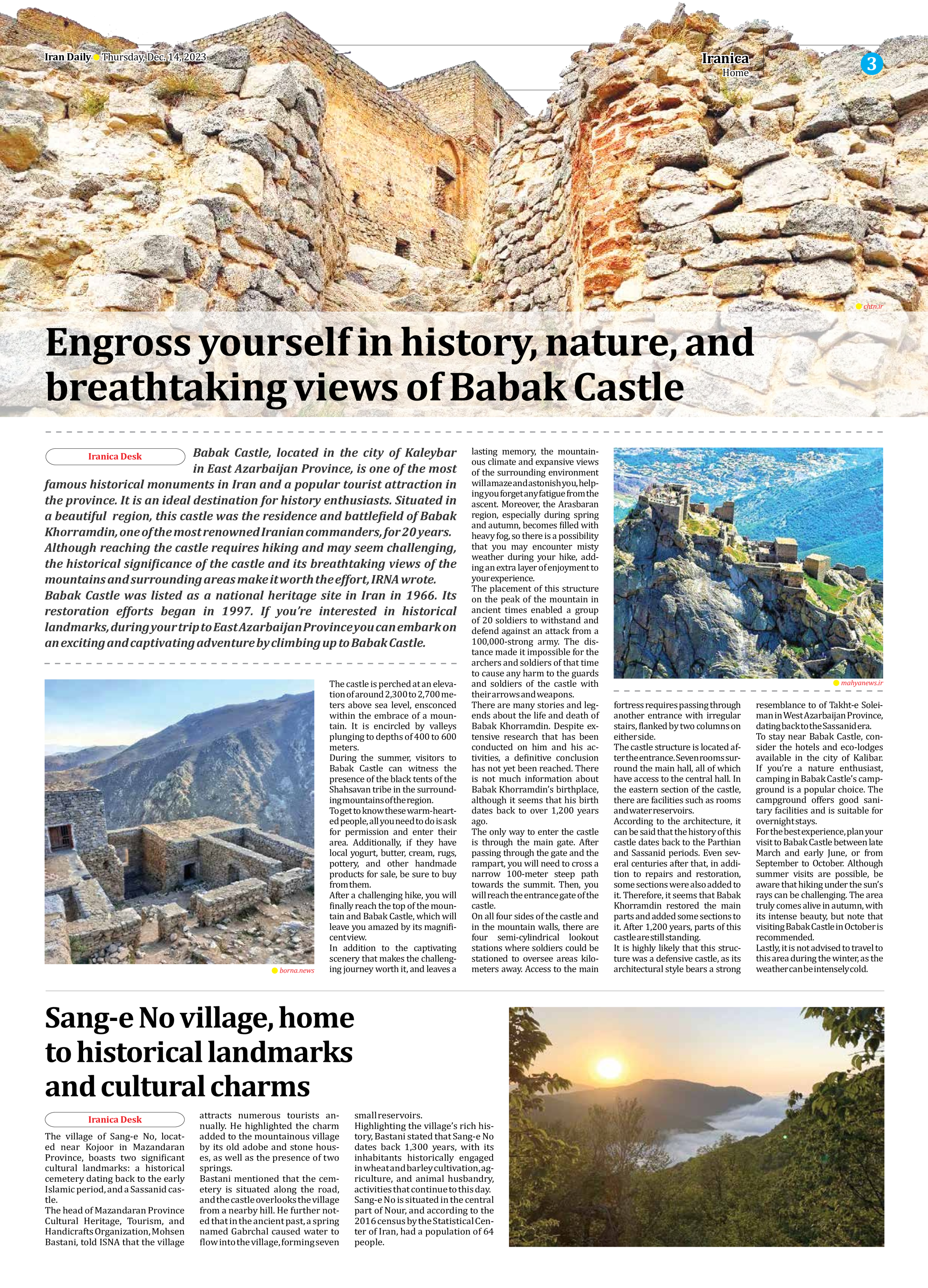
Engross yourself in history, nature, and breathtaking views of Babak Castle
Babak Castle, located in the city of Kaleybar in East Azarbaijan Province, is one of the most famous historical monuments in Iran and a popular tourist attraction in the province. It is an ideal destination for history enthusiasts. Situated in a beautiful region, this castle was the residence and battlefield of Babak Khorramdin, one of the most renowned Iranian commanders, for 20 years.
Although reaching the castle requires hiking and may seem challenging, the historical significance of the castle and its breathtaking views of the mountains and surrounding areas make it worth the effort, IRNA wrote.
Babak Castle was listed as a national heritage site in Iran in 1966. Its restoration efforts began in 1997. If you’re interested in historical landmarks, during your trip to East Azarbaijan Province you can embark on an exciting and captivating adventure by climbing up to Babak Castle.
The castle is perched at an elevation of around 2,300 to 2,700 meters above sea level, ensconced within the embrace of a mountain. It is encircled by valleys plunging to depths of 400 to 600 meters.
During the summer, visitors to Babak Castle can witness the presence of the black tents of the Shahsavan tribe in the surrounding mountains of the region.
To get to know these warm-hearted people, all you need to do is ask for permission and enter their area. Additionally, if they have local yogurt, butter, cream, rugs, pottery, and other handmade products for sale, be sure to buy from them.
After a challenging hike, you will finally reach the top of the mountain and Babak Castle, which will leave you amazed by its magnificent view.
In addition to the captivating scenery that makes the challenging journey worth it, and leaves a lasting memory, the mountainous climate and expansive views of the surrounding environment will amaze and astonish you, helping you forget any fatigue from the ascent. Moreover, the Arasbaran region, especially during spring and autumn, becomes filled with heavy fog, so there is a possibility that you may encounter misty weather during your hike, adding an extra layer of enjoyment to your experience.
The placement of this structure on the peak of the mountain in ancient times enabled a group of 20 soldiers to withstand and defend against an attack from a 100,000-strong army. The distance made it impossible for the archers and soldiers of that time to cause any harm to the guards and soldiers of the castle with their arrows and weapons.
There are many stories and legends about the life and death of Babak Khorramdin. Despite extensive research that has been conducted on him and his activities, a definitive conclusion has not yet been reached. There is not much information about Babak Khorramdin’s birthplace, although it seems that his birth dates back to over 1,200 years ago.
The only way to enter the castle is through the main gate. After passing through the gate and the rampart, you will need to cross a narrow 100-meter steep path towards the summit. Then, you will reach the entrance gate of the castle.
On all four sides of the castle and in the mountain walls, there are four semi-cylindrical lookout stations where soldiers could be stationed to oversee areas kilometers away. Access to the main fortress requires passing through another entrance with irregular stairs, flanked by two columns on either side.
The castle structure is located after the entrance. Seven rooms surround the main hall, all of which have access to the central hall. In the eastern section of the castle, there are facilities such as rooms and water reservoirs.
According to the architecture, it can be said that the history of this castle dates back to the Parthian and Sassanid periods. Even several centuries after that, in addition to repairs and restoration, some sections were also added to it. Therefore, it seems that Babak Khorramdin restored the main parts and added some sections to it. After 1,200 years, parts of this castle are still standing.
It is highly likely that this structure was a defensive castle, as its architectural style bears a strong resemblance to of Takht-e Soleiman in West Azarbaijan Province, dating back to the Sassanid era.
To stay near Babak Castle, consider the hotels and eco-lodges available in the city of Kalibar. If you’re a nature enthusiast, camping in Babak Castle’s campground is a popular choice. The campground offers good sanitary facilities and is suitable for overnight stays.
For the best experience, plan your visit to Babak Castle between late March and early June, or from September to October. Although summer visits are possible, be aware that hiking under the sun’s rays can be challenging. The area truly comes alive in autumn, with its intense beauty, but note that visiting Babak Castle in October is recommended.
Lastly, it is not advised to travel to this area during the winter, as the weather can be intensely cold.







